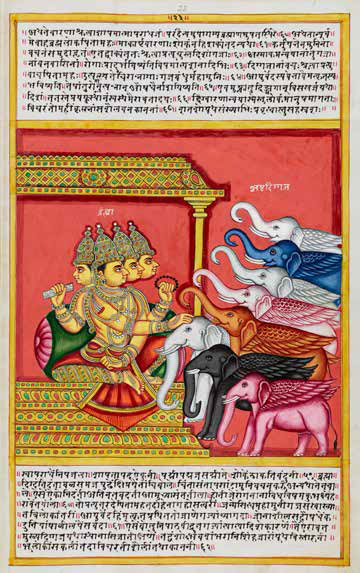Sanskrit and South Asian Manuscripts Digitization Project
The Bodleian Libraries are digitizing 100 manuscript works of Sanskrit and related South Asian manuscripts.
The Bodleian is proud to be the repository of some 8,700 Sanskrit manuscripts, the largest known collection outside the Indian subcontinent. From the first South Asian acquisitions gifted by Archbishop William Laud between 1635 and 1640, the manuscript collection expanded through donations in the 19th century (including the personal library of Horace Wilson, the first Boden Professor of Sanskrit), and a donation of over 6,000 manuscripts by the Prime Minister of Nepal, the Maharajah Sir Chandra Shum Shere, in 1909.
In 1927, the library’s Sanskrit manuscript collection was further enriched when the Indian Institute Library, which had been founded by the second Boden Professor of Sanskrit, Sir Monier Monier-Williams, came under Bodleian management.
The collection spans approximately 1,000 years of the continent’s cultural heritage, and covers every branch of Sanskrit literature. It also includes a smaller number of manuscripts in Tamil, Prakrit, Marathi, Pali and other Indic languages.
This project will digitize a number of important works from the collection, including:
- A wonderfully illuminated copy of Pālakāpya’s Treatise on Elephants (MS. Ind. Inst. Sank. 2), written on Western paper between 1874 and 1878.
- A trilingual manuscript of the Mañjuśrīnāmasaṅgīti (MS. Asiat. Misc. d. 8).
- The oldest manual for the ordination of Buddhist nuns (MS. Sansk. c. 25 (R)).
- Kālidāsa’s Abhijñānaśakuntala with William Jones’ translation (MS. Sansk. c. 37).
It will also digitize items identified as particularly valuable for teaching and research, to support classroom work and private study for students and teachers alike.
The digitization of these manuscript works has been made possible through a benefaction from the late John P. Clay, an alumnus of the University of Oxford and founder and benefactor of the Clay Sanskrit Library (CSL). As part of its aim to bring great works of Sanskrit literature to a worldwide audience, the CSL has prepared editions of 56 works of Classical Sanskrit literature spanning two millennia, including 20 titles that are also available in digital format, as described in the Digital Clay Sanskrit Library (eCSL).
The Bodleian project is planned to complete in October 2025.
Read more about the Bodleian’s collection of Sanskrit and South Asian Manuscripts.
THE BODLEIAN COLLECTION OF SANSKRIT MANUSCRIPTS
Viewing and Searching the Bodleian Collection Page
Objects belonging to the Sanskrit and South Asian Manuscripts Digitization Project can be browsed using the project’s collection page.
Search options are available down the left of the page alongside the collection objects. A search can be performed by entering terms in the ‘Search collection’ field, and objects can be filtered by facets including language and date. Search options can be used in isolation or in combination.
Above the search results there is an option to toggle whether objects are to be displayed in a list or thumbnail view. To the right of this there are options to change the number of results displayed per page, and several sorting options.
Search results show core information about an object, including the shelfmark, title, and number of images. Clicking on a thumbnail or shelfmark will take the user through to the object viewer.
Searches and objects can be saved for later viewing by creating a Digital Bodleian user account.
Using the Object Viewer
The object viewer interface is comprised of three panels:
- At the center and occupying most of the interface is the main image viewer, providing a detailed view of individual object images
- To the left of this is the thumbnail browser, allowing for at-a-glance visual navigation of the object
- The rightmost panel contains text-based descriptive metadata split into three tabs:
- About is the main metadata record for the object
- Contents contains descriptions of individual works within an object, where present
- Search contents searches descriptive metadata within an object, where it contains multiple works
The size of each of these panels can be adjusted by clicking and dragging from the edge of either of the side panels in a left or rightward direction. The left and right panels can be hidden entirely by clicking and dragging to the left, or right, respectively.
Objects can be navigated in a number of ways using this interface:
- Via the thumbnail browser
- Using the navigation bar above the main image
- Selecting a specific part of the object via the ‘Contents’ panel, where present
- Performing a search via the ‘Search Contents’ panel
There are additional controls in the main image viewing area. Moving the cursor to the upper left reveals zoom and rotate controls.
Above the main image viewer are options to view the object in the following modes:
- Single-image view (default)
- Two-image view
- Thumbnail gallery
- Full-screen view
Administrative metadata relating to the object can be found below the object viewer.
Read more about the Clay Sanskrit Library.

One of the treasures of the Bodleian’s Sanskrit collections: an illuminated copy of Pālakāpya’s Treatise on Elephants, 1874-1878. MS. Ind. Inst. Sansk. 2, fol. 23r.